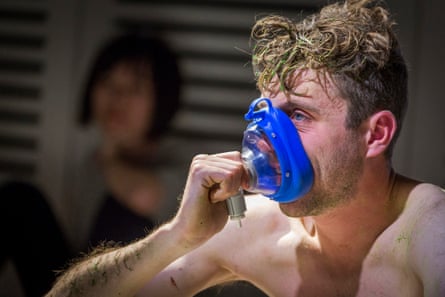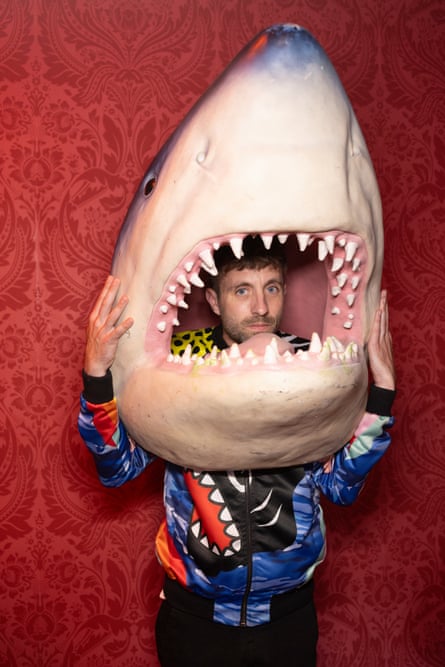It’s not often you meet someone who self-identifies as a zombie. Are your pronouns he, she, they – or it, I ask. “Let’s go with ‘it’!” laughs Martin O’Brien, the most jovial zombie you could hope to meet. He (the pronoun he actually uses) is serving tea and Tunnock’s tea cakes on a hospital trolley in his studio in an LGBTQ+ art space in south London. On shelves are large fake shark’s heads (“my beautiful babies!”), and the wall boasts a picture of O’Brien naked, pretending to nail his penis to a table – a homage to his artistic forefather, the late Bob Flanagan (who did it for real, while singing If I Had a Hammer, in a work called Nailed).
A performance artist from Burnley, with a strong Lancashire accent, O’Brien calls himself a zombie because he has outlived his life expectancy as a person with cystic fibrosis. When he was born in 1987, people afflicted by his incurable condition, which clogs the lungs and other vital organs with mucus, were unlikely to live much past 30. “I’d been obsessed with the idea that I was going to die when I was 30, but when I got to 28, I realised that unless something went drastically wrong I was going to live for longer,” he says. “I started to think about a zombie being alive and dead at the same time and I thought, ‘I’m becoming a zombie.’ It felt like a playful, camp metaphor, but also a useful way of thinking about mortality and life-shortening illness.”
O’Brien is 36 next month, “so an old, old man”, though he says he has benefited from strides in treatment: people with cystic fibrosis born in 2023 have a life expectancy between 42 and 50. A drug he started taking in lockdown has improved his lung function and reduced the cough CF sufferers are plagued by: “If you’d have met me four years ago I would have coughed every 20 seconds, but now it’s just a few times a day.” In fact I cough before he does, which makes him laugh. “Exercise is still the thing that makes me cough, so in the performances after a big coughing fit you hear people coughing all over the audience – it’s quite interesting.”

In 2015, to explore his feelings about living in “zombie-time”, he did a zombie-themed performance during which he was chained to a pole and bit several audience members. “I’m scared of death,” he says, “but I’m not scared of talking about it, and I think that making the work is a way of confronting it, and making it open, but also trying to understand what it means to be dying, or to be born with death as your sidekick.”
O’Brien has performed at several major art venues around the world, including Tate Modern, and is currently writer-in-residence at the Whitechapel gallery in London. This Saturday he will stage a four-hour ritual there called Overture to the End (An Ashen Place), which he describes as “an attempt to be immortal”. At the start of it, “I’ll be mummified. You begin with clingfilm as the first layer, and then you put tape over it.” His co-star is Sheree Rose, an 81-year-old ex-dominatrix from Los Angeles, and Flanagan’s former partner, with whom O’Brien has collaborated for over a decade. “She bosses me around constantly but she has this maternal instinct too and we play on that in the work: me as this sickly child, her as this ageing and sickly mother.”
Rose plays a banshee figure – “a bringer of death”, says O’Brien – who will periodically engage him in painful, BDSM-inspired tasks. In the course of his art, O’Brien has been cut, tattooed, spanked, burned, whipped, suffocated, pierced with needles, showered with effluent and strung up naked by his ankles – though all, he is careful to point out, at his instigation, and with his consent. “The pain that my body’s going to be under, it’s my choice.”
When O’Brien first started making this punishing work, a large part of the motivation was to push his illness-assailed body, and in doing so, regain some control over it. Does anything ever go wrong? “Yes,” he says. “About 10 years ago I had a performance with Sheree and there was a section where I was strung up, spreadeagled, blindfolded, I had pegs on my nipples and testicles and a butt plug up. I thought, ‘Ooh, I feel a bit strange’ and I fainted. The assistants ran over, took me down, carried me over to a bed and this quite beautiful, tender thing happened where Sheree put water on my head, gave me something to drink and I started to come back round again, so that becomes part of the performance. I like those moments where you see the fragility and vulnerability of the human body.”

People often ask O’Brien what his family think of his work. His sister is “a big fan and has assisted me – she’s a nurse”. His mum “knows the kind of work I do but she doesn’t want to hear about it and I can understand that. And my dad found it really hard when he came to watch a performance” – not surprisingly, given that it involved O’Brien being buried in soil “until it was too hard to breathe and then I would burst out of it”.
His parents had both been unaware that they carried the cystic fibrosis gene, but realised that something was wrong soon after their son was born. “At six weeks old I was skinny as a rake, eating and crying constantly.” A doctor deduced that O’Brien had the disease after hearing that a cousin in Ireland also suffered from it. When O’Brien was eight, the cousin died aged 12. “I never met him,” he says. “We weren’t close, but I remember my mum and dad coming into my bedroom to say, ‘Little Paddy’s died.’ I guess that was a switch into thinking, ‘Oh shit, there’s something up here with this disease.’ They’d brought me up knowing what it was, but I think being hit with that, something happens, and that’s where my obsession with death really started.”
As well as becoming deeply religious, something that has since “fallen away”, O’Brien became preoccupied with ghosts and especially sharks, which frequently appear in his work. “They’re an obvious metaphor for death, and that kind of pure fear, but there’s also the idea that if you’re in a body of water there’s always the potential of a shark lurking underneath, and that started to feel like illness too. It’s always there and if it wants you, it’s going to come and get you.”

At 13, O’Brien began to notice the difference between himself and his peers. “None of them take medication, none of them cough, they can go for a run without stopping.” He was also coming to terms with his sexuality, but didn’t know a single other gay person in Burnley. “That was difficult, figuring out sexuality in this pretty hyper-masculine and Catholic context that I was brought up in. But my immediate family were very accepting.”
His life changed in his late teens when he saw a picture in a book called The Artist’s Body. “It was a closeup of a scrotum and the skin is wrapped around the penis and sewn together so the penis vanishes, and then two nails are hammered through the edges of the skin attaching it to a plank of wood on the table. My reaction was ‘Argh, what is that?’ It was so disturbing an image.” O’Brien went on to read that the picture was by Flanagan, and that he also had cystic fibrosis. O’Brien didn’t know any fellow sufferers, since people with CF can’t be in close proximity with one another because of the risks of cross-infection. “That was a turning point – so art can be a place where we explore pain, pleasure, illness, love, passion, relationships. And then I started to discover artists like David Wojnarowicz and Audre Lorde, who were dealing politically and philosophically with life, death and illness” – Aids in the case of Wojnarowicz, and cancer in that of Lorde.
These artists showed O’Brien a way to turn the humiliation and physical pain inflicted on him by his illness into art. “Medicine is keeping me alive and it’s amazing, but I have to give full control to the doctors so I can continue living. Illness and its treatments strip you of agency and it feels like art is a place – maybe the only place – where you can regain agency over your body.”
For instance, in an early show called Mucus Factory, in 2011, O’Brien violently pounded his chest to loosen the phlegm (something CF patients have to do several times a day), coughed it up and used it to gel his hair, stick glitter to his body, and as lubrication so he could push a nebuliser – a device that helps him to breathe – into his rectum. “Performance is a space in which I can be sick in the way I want to be,” he says. “It’s gross and abject but it’s sexy and silly and moving and funny sometimes. The mucus that’s filling my lungs and killing me becomes a material to use in the work, so I can reclaim it.” His performances, he says, turn his disease into images, and through making it visible, allow him to take ownership of it. “In a way,” he says, “I’m grateful that I have cystic fibrosis because I wouldn’t be an artist if I didn’t.”
-
Overture for the End (An Ashen Place) is at the Whitechapel Gallery, London, on Saturday.
"artist" - Google News
July 18, 2023 at 11:41PM
https://ift.tt/rYU5MiH
‘I was born with death as my sidekick’: the ‘zombie’ with cystic fibrosis who turns pain into art - The Guardian
"artist" - Google News
https://ift.tt/O0AFBSK
Bagikan Berita Ini














0 Response to "‘I was born with death as my sidekick’: the ‘zombie’ with cystic fibrosis who turns pain into art - The Guardian"
Post a Comment